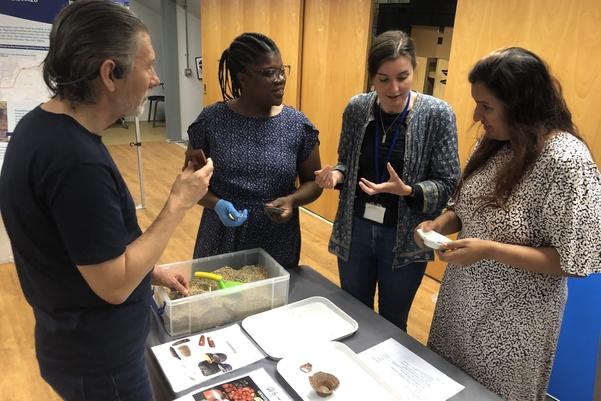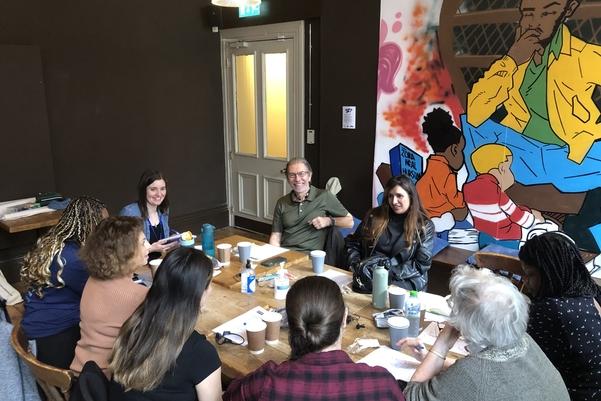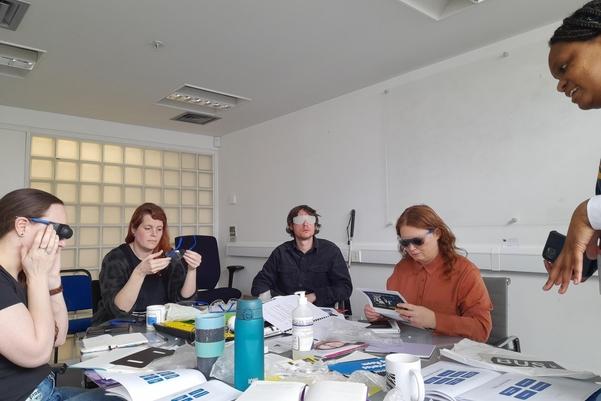Visual Impairment Heritage Partnership
IAA project type: Partnership grant
Duration of project: April 2024 to September 2024
Partner organisation: Eyes4Positivity
Individual partner: Ramona Williams, Eyes4Positivity Consultant
MOLA staff: Lawrence Northall (project lead), Katrina Foxton (project co-lead), Cat Gibbs (support & evaluation)
Project aims
Visual Impairment Heritage Partnership aims to deliver workshops alongside Eyes4Positivity, with individuals that have lived experience of visual impairment (VIPs). Using co-design heritage engagement strategies, and drawing on MOLA projects as case studies, the project aims to establish publicly accessible guidance on visual impairment inclusivity for the benefit of practitioners in the sector looking to work with or provide for VIP heritage audiences.
Audiences
-
VIP heritage audiences
-
Heritage organisations and practitioners interested in improving inclusivity
-
Eyes4Positivity
Project Plan
Four workshops with partner organisation will generate knowledge exchange and use co-design to study the feasibility of VIP inclusive methods within MOLA and the wider heritage sector. These will result in an accessible guidance document outlining best practice for VIP inclusivity through a range of engagement strategies.
April
- Eyes4Positivity upskill MOLA staff & provide VIP accessibility training prior to workshops.
- Accessibility needs of participants were gathered, workshops resources designed - including briefing documents, consent forms, ethics and safeguarding documentation, and evaluation forms.
May
- Project Partner co-design
- Accessibility needs discussed, co-design process drafted, and MOLA cases studies discussed in agreement with project partner.
June - July
-
Learnings from UNPATH’s VIP co-design process and UNPATH VIP feedback were drawn upon to further determine the approach for workshops.
This led to the design of the following 4 workshops:
Workshop 1: Barriers and opportunities in cultural/heritage engagement
General discussion of VIP experiences and perceptions of cultural / heritage engagement.
Workshop 2: Historical research as a form of engagement
Discussion of historical and archival records as a form of engagement using MOLA projects as case studies e.g., Coasts in Mind. Records were not limited to documentary evidence including video, audio, tactile objects, etc.
Workshop 3: Heritage dissemination methods
Critical engagement with MOLA projects as ‘pop up’ exhibitions e.g. Red Lion Court, A428, and Brentford Waterside (podwalks).
‘Tabla Rasa’ exercise allows VIPs a chance to design their own hypothetical exhibitions (within perimeters of a brief).
Workshop 4: Guidance document co-design & evaluation
Drawing on the knowledge gathered in workshops 1-3, VIPs were invited to discuss the structure of the guidance, any final topics or subject matters of interest, and the final evaluation of the project.
August - September
-
Analysis of participants' evaluative feedback to inform co-design learnings.
-
Production of MOLA guidance toolkit document, outlining inclusive engagement methods for VIPs.
-
Report produced evaluating the project methods and outcomes.
Project outputs
Download our project evaluation report and VIHP inclusivity guidance.
Project evaluation report
Project evaluation report (Large Print)
VIHP Inclusivity Guidance
VIHP inclusivity guidance (Large Print)
Project impacts
The benefits of the VIHP project are numerous.
Firstly, the MOLA staff were trained by Eyes4Positivity. Feedback quotes from MOLA staff show the impact of Sight Loss Awareness training:
I feel that I have a greater understanding of the daily challenges faced by those with different types of impairments and how this can impact choices (of what a VIP decides to do with their lives!)
I now feel deeper understanding and therefore more confidence to speak up and support VIPs.
MOLA staff have been upskilled and can impart their knowledge and awareness for VIPs in future projects.
Secondly, the VIPs involved found the codesign workshops to be a positive experience:
It's been a really worthwhile experience…it’s great to have an opportunity for our voices to be heard and I really feel they have been [heard] and understood… whereas in all too many situations we’re heard and ignored - Andrew (VIHP participant)
Other legacy impacts include:
- Plans for ongoing work with Eyes4Positivity in the form of a new application proposing another IAA, which focuses on working with VIPs to develop 3D-printed archaeological objects and sites.
- A new article is to be written for the Curator publishers, focusing on the Unpath’d Waters project findings, and this will make considerable reference to the guidance toolkit and evaluation reflections from the VIHP project.
On sharing the guidance toolkit with their networks, Eyes4Positivity received positive feedback from a representative of the local Inclusive Design Review Panel:
Thank you so much for sharing the visually impaired heritage partnership report. I will share this with […] the council’s Urban Design and Heritage Team Leader.
Lastly, the Public Impact strategy incorporates learnings from VIHP project for future work and evaluation frameworks.


